
A geyser is a spring characterized by an intermittent discharge of water ejected turbulently and accompanied by steam. As a fairly rare phenomenon, the formation of geysers is due to particular hydrogeological conditions that exist only in a few places on Earth. Generally all geyser field sites are located near active volcanic areas, and the geyser effect is due to the proximity of magma. Generally, surface water works its way down to an average depth of around 2,000 metres (6,600 ft) where it contacts hot rocks. The resultant boiling of the pressurized water results in the geyser effect of hot water and steam spraying out of the geyser's surface vent.
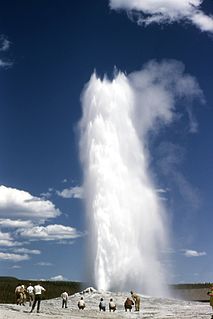
Old Faithful is a cone geyser in Yellowstone National Park in Wyoming, United States. It was named in 1870 during the Washburn–Langford–Doane Expedition and was the first geyser in the park to be named. It is a highly predictable geothermal feature and has erupted every 44 minutes to two hours since 2000. The geyser and the nearby Old Faithful Inn are part of the Old Faithful Historic District.

The geothermal areas of Yellowstone include several geyser basins in Yellowstone National Park as well as other geothermal features such as hot springs, mud pots, and fumaroles. The number of thermal features in Yellowstone is estimated at 10,000. A study that was completed in 2011 found that a total of 1,283 geysers have erupted in Yellowstone, 465 of which are active during an average year. These are distributed among nine geyser basins, with a few geysers found in smaller thermal areas throughout the Park. The number of geysers in each geyser basin are as follows: Upper Geyser Basin (410), Midway Geyser Basin (59), Lower Geyser Basin (283), Norris Geyser Basin (193), West Thumb Geyser Basin (84), Gibbon Geyser Basin (24), Lone Star Geyser Basin (21), Shoshone Geyser Basin (107), Heart Lake Geyser Basin (69), other areas (33). Although famous large geysers like Old Faithful are part of the total, most of Yellowstone's geysers are small, erupting to only a foot or two. The hydrothermal system that supplies the geysers with hot water sits within an ancient active caldera. Many of the thermal features in Yellowstone build up sinter, geyserite, or travertine deposits around and within them.

Grand Geyser is a fountain geyser in the Upper Geyser Basin of Yellowstone National Park in the United States. It is the tallest predictable geyser known. It was named by Dr. F.V. Hayden in 1871.
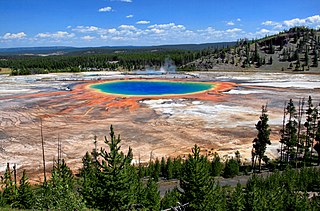
The Grand Prismatic Spring in Yellowstone National Park is the largest hot spring in the United States, and the third largest in the world, after Frying Pan Lake in New Zealand and Boiling Lake in Dominica. It is located in the Midway Geyser Basin.
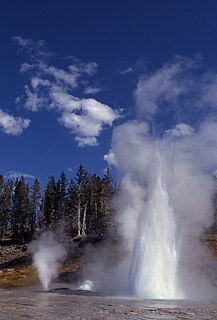
Vent Geyser is a geyser in the Upper Geyser Basin of Yellowstone National Park in the United States.

Turban Geyser is a geyser in the Upper Geyser Basin of Yellowstone National Park in the United States.
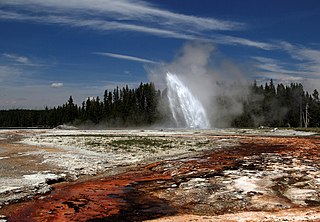
Daisy Geyser is a geyser in the Upper Geyser Basin of Yellowstone National Park in the United States.

Young Hopeful Geyser and Grey Bulger Geyser are two separate geysers that share the same pool in the Lower Geyser Basin of Yellowstone National Park in the United States. Both geysers are part of the Black Warrior Group which includes Artesia Geyser and Steady Geyser.

Excelsior Geyser Crater, formerly known as Excelsior Geyser, is a dormant fountain-type geyser in the Midway Geyser Basin of Yellowstone National Park in the United States. Excelsior was named by the Hayden Geological Survey of 1871.

Emerald Spring is a hot spring located in Norris Geyser Basin of Yellowstone National Park.
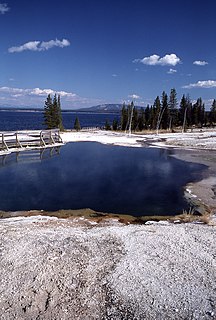
Black Pool is a hot spring in the West Thumb Geyser Basin of Yellowstone National Park in the United States.

Jet Geyser is a geyser in the Lower Geyser Basin of Yellowstone National Park in the United States. Jet Geyser is in the Fountain Group that includes Fountain Geyser, Morning Geyser, Red Spouter and Silex Spring.
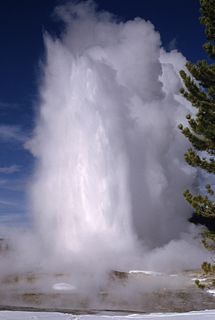
Giant Geyser is a cone-type geyser in the Upper Geyser Basin of Yellowstone National Park in the United States. Giant Geyser is the namesake for the Giant Group of geysers, which, on its platform, includes Bijou Geyser, Catfish Geyser, Mastiff Geyser, the "Platform Vents," and Turtle Geyser. Giant Geyser's Platform, a raised stone structure incorporating all these geysers. Giant is notable for its spectacular, but sporadic eruptions, as well as for its very large cone of geyserite, which stands about 12 feet tall.
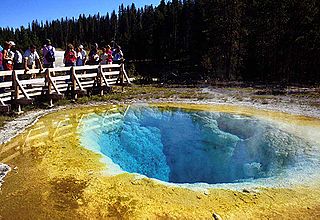
Morning Glory Pool is a hot spring in the Yellowstone Upper Geyser Basin of the United States. The spring is also known by the name Morning Glory Spring.
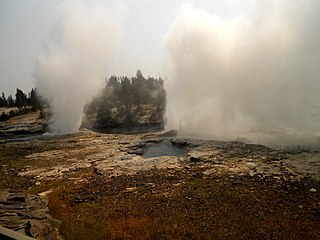
Fan and Mortar Geysers are two geysers in the Upper Geyser Basin in Yellowstone National Park. For the past several decades, they have erupted in concert with one another and are generally talked about together. The records detailing these geysers' known eruptive history shows that they have been infrequent and irregular performers.

Spasmodic Geyser is a geyser located in the Upper Geyser Basin in Yellowstone National Park in the United States.

Doublet Pool is a hot spring in the Upper Geyser Basin of Yellowstone National Park, Wyoming.

Jewel Geyser is a fountain geyser in the Upper Geyser Basin of Yellowstone National Park in the United States. It is in the Biscuit Basin complex that includes Black Diamond Pool, Black Opal Spring, Wall Pool, Sapphire Pool, Shell Spring, Silver Globe Spring, Avoca Spring, West Geyser, the Mustard Springs, Coral Geyser, and Black Pearl Geyser.
Semi-Centennial Geyser is located just north of Roaring Mountain in Yellowstone National Park in the U.S. state of Wyoming. Situated next to the Grand Loop Road, the geyser was first noticed when it had a few small eruptions in 1919. A few years later at 6:40am on August 14, 1922 the geyser erupted in the first of a series of increasingly violent eruptions. By the afternoon on the same day reports stated that the ejected water was exceeding 300 feet (91 m) in height. By the evening of the 14th, the geyser had scattered debris and rocks a distance of 450 ft (140 m) from the crater. Short lived, Semi-Centennial Geyser has been quiet since and a small pool of water now exists where the geyser erupted. As the geyser showed its biggest activity in 1922, the 50th anniversary of the establishment of Yellowstone National Park in 1872, it was accorded the name of Semi-Centennial.




















